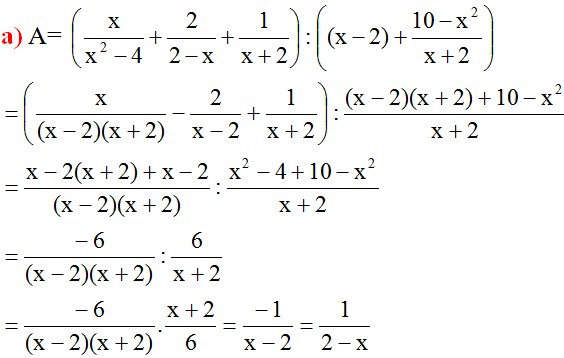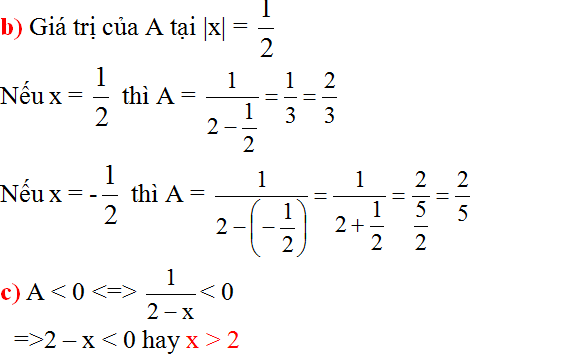Hãy nhập câu hỏi của bạn vào đây, nếu là tài khoản VIP, bạn sẽ được ưu tiên trả lời.

\(ĐKXĐ:x\ne-3;2\)
\(\frac{x+2}{x+3}-\frac{5}{x^2+x-6}-\frac{1}{x-2}=\frac{x+2}{x+3}-\frac{5}{\left(x+3\right)\left(x+2\right)}-\frac{1}{x-2}\)
\(=\frac{x^2+4x+4}{\left(x+3\right)\left(x+2\right)}-\frac{5}{\left(x+3\right)\left(x+2\right)}-\frac{x+3}{\left(x+2\right)\left(x+3\right)}\)
\(=\frac{x^2+4x+4-5-x-3}{\left(x+2\right)\left(x+3\right)}=\frac{x^2+3x-4}{\left(x+3\right)\left(x+2\right)}=\frac{\left(x+4\right)\left(x-1\right)}{\left(x+3\right)\left(x+2\right)}\)
\(x^2-9=0\Leftrightarrow x=3\left(vì:x\ne-3\right)\)
\(\Rightarrow P=\frac{7}{15}\)
\(P\inℤ\Leftrightarrow x^2+3x-4⋮x^2+5x+6\Leftrightarrow2x+10⋮x^2+5x+6\Leftrightarrow12⋮x^2+5xx+6\)
\(................\left(dễ\right)\)
P/s: shitbo sai rồi nha bạn!Nếu không tin thì thay x = 3 vào P ban đầu và giá trị P sau khi rút gọn sẽ thấy sự khác biệt =)
ĐK: \(x\ne-3;x\ne2\)
a) \(P=\frac{x+2}{x+3}-\frac{5}{x^2+x-6}-\frac{1}{x-2}\)
\(=\frac{x^2-4}{\left(x+3\right)\left(x-2\right)}-\frac{5}{\left(x-2\right)\left(x+3\right)}-\frac{x+3}{\left(x-2\right)\left(x+3\right)}\)
\(=\frac{x^2-x-12}{\left(x+3\right)\left(x-2\right)}=\frac{\left(x-4\right)\left(x+3\right)}{\left(x+3\right)\left(x-2\right)}=\frac{x-4}{x-2}\)
b) \(x^2-9=0\Leftrightarrow x^2=9\Leftrightarrow x=\pm3\)
Thay vào điều kiện,tìm loại x = -3 .Tìm được x =3
Ta có: \(P=\frac{x-4}{x-2}=\frac{3-4}{3-2}=-1\)
c)Ta có: \(P=\frac{x-4}{x-2}=\frac{x-2-2}{x-2}=1-\frac{2}{x-2}\)
Để P có giá trị nguyên thì \(\frac{2}{x-2}\) nguyên hay \(x-2\inƯ\left(2\right)=\left\{\pm1;\pm2\right\}\)
Suy ra \(x=\left\{0;1;3;4\right\}\)

a ) \(D=\left(\dfrac{1}{1-x}+\dfrac{1}{1+x}\right):\left(\dfrac{1}{1-x}-\dfrac{1}{1+x}\right)+\dfrac{1}{x+1}\)
\(=\left(\dfrac{1+x+1-x}{\left(1-x\right)\left(1+x\right)}\right):\left(\dfrac{1+x-1+x}{\left(1-x\right)\left(1+x\right)}\right)+\dfrac{1}{x+1}\)
\(=\dfrac{2}{\left(1-x\right)\left(1+x\right)}:\dfrac{2x}{\left(1-x\right)\left(1+x\right)}+\dfrac{1}{x+1}\)
\(=\dfrac{2}{\left(1-x\right)\left(1+x\right)}.\dfrac{\left(1-x\right)\left(1+x\right)}{2x}+\dfrac{1}{x+1}\)
\(=\dfrac{1}{x}+\dfrac{1}{x+1}\)
\(=\dfrac{x+1+x}{x\left(x+1\right)}=\dfrac{2x+1}{x\left(x+1\right)}\)
b ) Khi \(x^2-x=0\Leftrightarrow x\left(x-1\right)=0\Leftrightarrow\left[{}\begin{matrix}x=0\\x=1\end{matrix}\right.\)
Thay 0,1 vào biểu thức D
Khi \(x=0\), ta có :
\(\dfrac{2.0+1}{0.\left(0+1\right)}\) ( ko được )
Khi \(x=1,\) ta có :
\(\dfrac{2.1+1}{1.\left(1+1\right)}=\dfrac{3}{2}\)
c ) Khi \(D=\dfrac{3}{2}\)
Ta có : \(\dfrac{2x+1}{x\left(x+1\right)}=\dfrac{3}{2}\)
\(\Leftrightarrow4x+2=3x^2+3x\)
\(\Leftrightarrow-3x^2+x+2=0\)
\(\Leftrightarrow\left[{}\begin{matrix}x=1\\x=-\dfrac{2}{3}\end{matrix}\right.\)
Vậy ...........

a) \(ĐKXĐ:\hept{\begin{cases}x\ne0\\x\ne-5\end{cases}}\)
\(P=\frac{x^2}{5x+25}+\frac{2x-10}{x}+\frac{50+5x}{x^2+5x}\)\(=\frac{x^2}{5\left(x+5\right)}+\frac{2\left(x-5\right)}{x}+\frac{5\left(x+10\right)}{x\left(x+5\right)}\)
\(=\frac{x^3}{5x\left(x+5\right)}+\frac{10\left(x-5\right)\left(x+5\right)}{5x\left(x+5\right)}+\frac{25\left(x+10\right)}{5x\left(x+5\right)}\)
\(=\frac{x^3+10\left(x-5\right)\left(x+5\right)+25\left(x+10\right)}{5x\left(x+5\right)}=\frac{x^3+10\left(x^2-25\right)+25x+250}{5x\left(x+5\right)}\)
\(=\frac{x^3+10x^2-250+25x+250}{5x\left(x+5\right)}=\frac{x^3+10x^2+25x}{5x\left(x+5\right)}\)\(=\frac{x\left(x^2+10x+25\right)}{5x\left(x+5\right)}\)\(=\frac{\left(x+5\right)^2}{5\left(x+5\right)}=\frac{x+5}{5}\)
b) \(x^2-3x=0\)\(\Leftrightarrow x\left(x-3\right)=0\)\(\Leftrightarrow\orbr{\begin{cases}x=0\\x-3=0\end{cases}}\Leftrightarrow\orbr{\begin{cases}x=0\\x=3\end{cases}}\)
So sánh với ĐKXĐ, ta thấy \(x=0\)không thoả mãn
Thay \(x=3\)vào biểu thức ta được: \(P=\frac{3+5}{5}=\frac{8}{5}\)
c) Để \(P=-4\)thì \(\frac{x+5}{5}=-4\)\(\Leftrightarrow x+5=-20\)\(\Leftrightarrow x=-25\)( thoả mãn ĐKXĐ )
Vậy \(P=-4\)\(\Leftrightarrow x=-25\)
d) Để \(P\ge0\)thì \(\frac{x+5}{5}\ge0\)\(\Leftrightarrow x+5\ge0\)( vì \(5>0\))\(\Leftrightarrow x\ge-5\)
So sánh với ĐKXĐ, ta thấy x phải thoả mãn \(x>-5\)và \(x\ne0\)
Vậy \(P\ge0\)\(\Leftrightarrow\)\(x>-5\)và \(x\ne0\)

Lời giải của bạn Nhật Linh đúng rồi, tuy nhiên cần thêm điều kiện để A có nghĩa: \(x\ne\pm2\)

1, a, để A có giá trị xác định <=> 5x-5y \(\ne\) 0 => 5x\(\ne\)5y =>x\(\ne\)y b, A=\(\dfrac{x^2-y^2}{5x-5y}=\dfrac{\left(x+y\right)\left(x-y\right)}{5\left(x-y\right)}=\dfrac{\left(x+y\right)}{5}\) 2, a,
A=\(\dfrac{2x^3+4x}{x^3-4x}+\dfrac{x^2-4}{x^2+2x}+\dfrac{2}{2-x}\) =\(\dfrac{2x\left(x+2\right)}{x\left(x^2-4\right)}+\dfrac{\left(x+2\right)\left(x-2\right)}{x\left(x+2\right)}-\dfrac{2}{x-2}\) =\(\dfrac{2x\left(x+2\right)}{x\left(x-2\right)\left(x+2\right)}+\dfrac{x-2}{x}-\dfrac{2}{x-2}\) =\(\dfrac{2x}{x\left(x-2\right)}+\dfrac{\left(x-2\right)^2}{x\left(x-2\right)}-\dfrac{2x}{x\left(x-2\right)}\) =\(\dfrac{2x+\left(x-2\right)^2-2x}{x\left(x-2\right)}\) =\(\dfrac{\left(x-2\right)^2}{x\left(x-2\right)}\) =\(\dfrac{\left(x-2\right)}{x}\)
b, thay x=4 vào A ta có : A=\(\dfrac{4-2}{4}\) =\(\dfrac{2}{4}=\dfrac{1}{2}\)
c, để A \(\in\) Z => (x-2)\(⋮\)x mà x\(⋮\)x =>-2\(⋮\)x => x\(\in\){ \(\pm1;\pm2\)} mà x\(\ne\)\(\pm2\) => x\(\in\left\{-1,+1\right\}\)
Bài 3 : a, Ta có B= 2.(-1)2+-(-1)+1 =2+1+1=4 b, Ta có A=2x3 +5x2 -2x +a =(2x3 -x2 +x )+(6x2-3x +3) +(a-3) \(⋮\) 2x2-x+1 => x(2x2-x+1)+3(2x2-x+1) +(a-3)\(⋮\) 2x2-x+1
=>a-3=0 (vì a-3 là số dư )=>a-3 Vậy a=3 thì A\(⋮\)B c,B=1 => 2x2 -x+1=1 =>x(2x-1)=0 => x=0 hoặc 2x-1 =0 => x=0 hoặc x=\(\dfrac{1}{2}\)

a,ĐK: \(\hept{\begin{cases}x\ne0\\x\ne\pm3\end{cases}}\)
b, \(A=\left(\frac{9}{x\left(x-3\right)\left(x+3\right)}+\frac{1}{x+3}\right):\left(\frac{x-3}{x\left(x+3\right)}-\frac{x}{3\left(x+3\right)}\right)\)
\(=\frac{9+x\left(x-3\right)}{x\left(x-3\right)\left(x+3\right)}:\frac{3\left(x-3\right)-x^2}{3x\left(x+3\right)}\)
\(=\frac{x^2-3x+9}{x\left(x-3\right)\left(x+3\right)}.\frac{3x\left(x+3\right)}{-x^2+3x-9}=\frac{-3}{x-3}\)
c, Với x = 4 thỏa mãn ĐKXĐ thì
\(A=\frac{-3}{4-3}=-3\)
d, \(A\in Z\Rightarrow-3⋮\left(x-3\right)\)
\(\Rightarrow x-3\inƯ\left(-3\right)=\left\{-3;-1;1;3\right\}\Rightarrow x\in\left\{0;2;4;6\right\}\)
Mà \(x\ne0\Rightarrow x\in\left\{2;4;6\right\}\)

1)
\(\Leftrightarrow\left(x^2-2+\dfrac{1}{x^2}\right)+\left(y^2-2+\dfrac{1}{y^2}\right)+z^2=0\)
\(\Leftrightarrow\left(x-\dfrac{1}{x}\right)^2+\left(y-\dfrac{1}{y}\right)^2+z^2=0\)
\(\left\{{}\begin{matrix}x-\dfrac{1}{x}=0\Rightarrow\left|x\right|=1\\y-\dfrac{1}{y}=0\Rightarrow\left|y\right|=1\\z=0\end{matrix}\right.\)
dk\(x,y,z,a,b,c\ne0\)\(\left\{{}\begin{matrix}\dfrac{a}{x}=A\\\dfrac{b}{y}=B\\\dfrac{c}{z}=C\end{matrix}\right.\) \(\Rightarrow A,B,C\ne0\)
\(\left\{{}\begin{matrix}A+B+C=2\\\dfrac{1}{A}+\dfrac{1}{B}+\dfrac{1}{C}=0\end{matrix}\right.\)
\(\left\{{}\begin{matrix}A^2+B^2+C^2+2\left(AB+BC+AC\right)=4\\\dfrac{ABC}{A}+\dfrac{ABC}{B}+\dfrac{ABC}{C}=0\end{matrix}\right.\)
\(\left\{{}\begin{matrix}AB+BC+AC=0\\A^2+B^2+C^2=4\end{matrix}\right.\)
\(\left(\dfrac{a}{x}\right)^2+\left(\dfrac{b}{y}\right)^2+\left(\dfrac{c}{z}\right)^2=4\)

\(A=\frac{x}{x+1}-\frac{3-3x}{x^2-x+1}+\frac{x+4}{x^3+1}\)
\(A=\frac{x\left(x^2-x+1\right)}{\left(x+1\right)\left(x^2-x+1\right)}-\frac{3-3x}{\left(x+1\right)\left(x^2-x+1\right)}+\frac{x+4}{\left(x+1\right)\left(x^2-x+1\right)}\)
\(A=\frac{x^3-x^2+x-3-3x+x+4}{\left(x+1\right)\left(x^2-x+1\right)}\)
\(A=\frac{1}{\left(x+1\right)\left(x^2-x+1\right)}=\frac{1}{x^3+1}\)


Lời giải:ĐK: $x\neq \pm 1$
a)
\(B=\frac{(x-1)^2-(x+1)^2}{(x+1)(x-1)}+\frac{4}{x^2-1}=\frac{x^2-2x+1-(x^2+2x+1)}{(x+1)(x-1)}+\frac{4}{(x-1)(x+1)}=\frac{-4x+4}{(x-1)(x+1)}=\frac{-4(x-1)}{(x-1)(x+1)}=\frac{-4}{x+1}\)
b)
Khi $x^2-x=0\Leftrightarrow x(x-1)=0\Leftrightarrow x=0$ hoặc $x=1$. Mà $x\neq \pm 1$ nên $x=0$
Khi đó: $B=\frac{-4}{0+1}=-4$